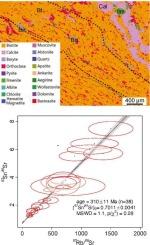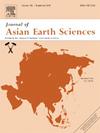内蒙古白云鄂博REE-Nb-Fe矿床原位化学成分及Rb-Sr年龄对热液套印的制约
IF 2.4
3区 地球科学
Q2 GEOSCIENCES, MULTIDISCIPLINARY
引用次数: 0
摘要
中国北方白云鄂博REE-Nb- fe矿床以稀土、铌等重要金属储量大而闻名。前人对矿床成因的研究主要集中在原生稀土、铌成矿的时间和成因上。然而,不同类型原生成矿作用的变形和热液套印时间没有得到很好的约束。黑云母板岩是该区重要的围岩之一,已发生热液蚀变和矿化。黑云母板岩由黑云母和方解石组成,少量含黄铁矿、磁铁矿/赤铁矿、钛铁矿和bastnäsite。黑云母呈弧形带状,部分被绿泥石和白云母所取代,显示出结晶后的韧性变形和流体蚀变。黑云母属于富镁品种,结晶温度为672℃~ 773℃。它的起源可能是岩浆,并被热液流体修饰。黑云母REE相对较低,Nb、F含量较高,可能受富Nb-F热液的改造,或继承了岩浆黑云母富集Nb、F的特征。对两个样品的原位Rb-Sr定年得到的Rb-Sr等时线年龄分别为310±11 Ma和309.4±9.3 Ma。黑云母的初始87Sr/86Sr比值在0.7011 ~ 0.7054之间,与地幔储层相似。结合前人的测年结果,我们的研究提供了海西期热液活动可能对铌矿化的限制。本文章由计算机程序翻译,如有差异,请以英文原文为准。

Constraints of in situ chemical compositions and Rb-Sr age of biotite on hydrothermal overprinting in the Bayan Obo REE-Nb-Fe deposit, Inner Mongolia, North China
The Bayan Obo REE-Nb-Fe deposit in Northern China is famous for its large reserves of critical metals such as REE and Nb. Previous studies about ore genesis mainly focused on the timing and origin of primary REE and Nb mineralization. However, the timing of deformation and hydrothermal overprinting on different types of primary mineralization was not well constrained. Biotite slate is one of significant wall rocks and has been hydrothermally altered and mineralized. The biotite slate is composed of biotite and calcite, with minor pyrite, magnetite/hematite, ilmenite, and bastnäsite. Biotite exhibits curved bands and is partially replaced by chlorite and muscovite, indicative of post-crystallization ductile deformation and fluid-induced alteration. Biotite belongs to the Mg-rich variety with the crystallization temperatures of 672 °C to 773 °C. It was possibly originally magmatic in origin and was modified by hydrothermal fluids. Biotite has relatively low REE and high Nb and F contents, probably reflecting modification by Nb-F-rich hydrothermal fluids or Nb and F enrichment inherited from magmatic biotite. In situ Rb-Sr dating of biotite from two samples yields Rb-Sr isochron ages of 310 ± 11 Ma and 309.4 ± 9.3 Ma, respectively. Biotite has initial 87Sr/86Sr ratios between 0.7011 and 0.7054, similar to those of mantle reservoirs. Together with previous dating results, our study provides constraints on the Hercynian hydrothermal activity which likely contributed to Nb mineralization.
求助全文
通过发布文献求助,成功后即可免费获取论文全文。
去求助
来源期刊

Journal of Asian Earth Sciences
地学-地球科学综合
CiteScore
5.90
自引率
10.00%
发文量
324
审稿时长
71 days
期刊介绍:
Journal of Asian Earth Sciences has an open access mirror journal Journal of Asian Earth Sciences: X, sharing the same aims and scope, editorial team, submission system and rigorous peer review.
The Journal of Asian Earth Sciences is an international interdisciplinary journal devoted to all aspects of research related to the solid Earth Sciences of Asia. The Journal publishes high quality, peer-reviewed scientific papers on the regional geology, tectonics, geochemistry and geophysics of Asia. It will be devoted primarily to research papers but short communications relating to new developments of broad interest, reviews and book reviews will also be included. Papers must have international appeal and should present work of more than local significance.
The scope includes deep processes of the Asian continent and its adjacent oceans; seismology and earthquakes; orogeny, magmatism, metamorphism and volcanism; growth, deformation and destruction of the Asian crust; crust-mantle interaction; evolution of life (early life, biostratigraphy, biogeography and mass-extinction); fluids, fluxes and reservoirs of mineral and energy resources; surface processes (weathering, erosion, transport and deposition of sediments) and resulting geomorphology; and the response of the Earth to global climate change as viewed within the Asian continent and surrounding oceans.
 求助内容:
求助内容: 应助结果提醒方式:
应助结果提醒方式:


